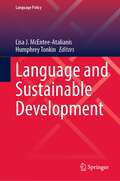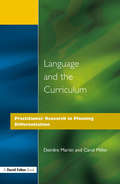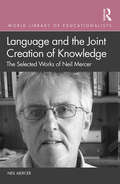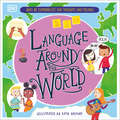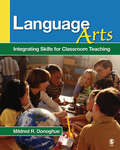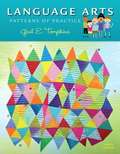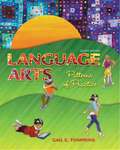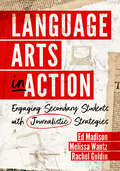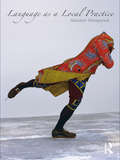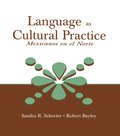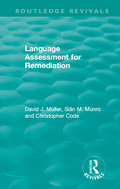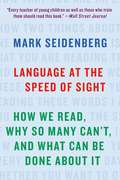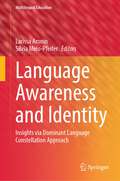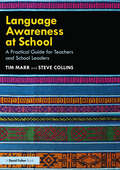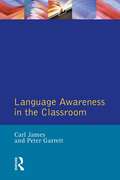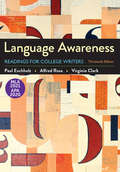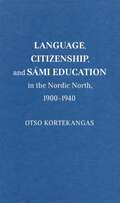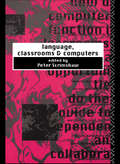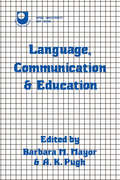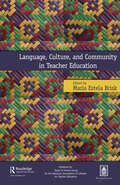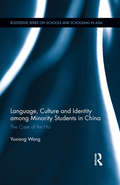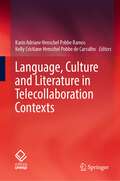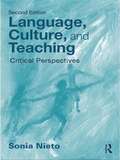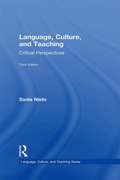- Table View
- List View
Language and Sustainable Development (Language Policy #32)
by Lisa J. McEntee-Atalianis Humphrey TonkinThis book addresses the importance of language in matters of sustainability and incorporating such concerns in implementing the UN’s Sustainable Development Goals (SDGs). Sustainable language policy must aim to include all groups, including language minorities and marginalized populations, such as refugees and aid recipients, in conditions that allow for their inclusion in making and implementing policy. The book brings together nine studies covering such topics as language and digital resources, sustainable and inclusive multilingual education, national language policy, and language in peacekeeping operations. A final chapter addresses the crucial intersection between sociolinguistics and economics, and the implications of this for development and the SDGs.
Language and the Curriculum: Practitioner Research in Planning Differentiation
by Carol Miller Deirdre MartinFirst Published in 1999. Routledge is an imprint of Taylor & Francis, an informa company.
Language and the Joint Creation of Knowledge: The selected works of Neil Mercer
by Neil MercerIn the World Library of Educationalists series, international experts themselves compile career-long collections of what they judge to be their finest pieces – extracts from books, key articles, salient research findings, major theoretical and practical contributions – so the world can read them in a single manageable volume. Readers will be able to follow the themes and strands and see how their work contributes to the development of the field. Language and the Joint Creation of Knowledge draws on the most prominent writing of Neil Mercer, covering his ground-breaking and critically acclaimed work on the role of talk in education, and on the relationship between spoken language and cognition. The text explores key themes, relating theoretical ideas to research evidence and to practical educational situations that improve children’s lives. Offering students and researchers a clear, accessible and up-to-date account of a sociocultural perspective on the relationship between spoken language and cognition, it explains one of the key themes in Neil Mercer’s work – that humans have uniquely evolved the capacity to think together, or ‘interthink’. Offering a crucial insight into the work of Neil Mercer, this selection showcases why his approach has become the dominant paradigm in educational research, and why it is increasingly influential in the psychology of teaching and learning. This unique collection of published articles and chapters, which represent the key themes and range of his research over the last 40 years, will be of interest to all followers of his work and any reader interested in the role of language in education.
Language Around the World: Ways we Communicate our Thoughts and Feelings
by Gill BudgellDiscover fascinating facts about communication in all its forms, from around the world and over timeEngaging factual writing introduces young readers to the most interesting aspects of languages, how they evolve and change over time. Humans&’ use of language is one of our distinguishing features. Language allows us to communicate what we think, what we want, what we feel, and what we have learned. Some 100,000 years ago, humans began speaking. Since then, we have developed nearly 7000 languages. Languages are living things; they evolve and change over time. They even travel! People carry their language with them and spread it. Large language families even have their own family trees, such as Spanish, French, English. Different languages can be mixed and combined to create new languages with similar words, pronunciation, and grammar rules. Languages can even become extinct if they are not shared and learned by each new generation. Spoken languages are not the only way we communicate. Sign language, Morse code, semaphore, smoke signals, computer codes - humans have invented numerous ways of communicating. Sharing feelings, thoughts, and ideas through the power of language is an essential part of being human.
Language Arts: Integrating Skills for Classroom Teaching
by Mildred R. DonoghueProvides a clear and succinct introduction to teaching the language arts to elementary studentsKey FeaturesFocuses on integrating the six language arts—reading, writing, listening, speaking, viewing, and visually representing—with other subject areasProvides guidance on differentiating instruction to bring out the best in the rapidly growing number of students with special needs and English language learners in the regular classroomIncludes a detailed lesson plan in each chapter along with instructional activities and techniques to integrate the language arts across all the subjects in the elementary curriculumAccompanied by High-Quality Ancillaries!Student Resource CD: Bundled with the book, this CD includes video clips and discussion questions that correlate with important chapter concepts.This interactive study site provides practice tests, flashcards, chapter summaries, links to NCTE/IRA and state-specific Language Arts standards, and much more.Instructor Resources on CD: Available by contacting SAGE Customer Care at 1-800-818-SAGE (7243), this CD for instructors offers resources such as lecture outlines, PowerPoint slides, a test bank, and sample syllabi for semester and quarter courses.Intended AudienceThis book is intended for undergraduate and graduate courses in elementary language arts methods, which teaches pre-service teachers and licensure/certification candidates specifically how to teach their students the basics of the six language arts – reading, writing, listening, speaking, viewing, and visually representing.
Language Arts: Patterns Of Practice
by Gail TompkinsThe best selling language arts text in the market, Language Arts: Patterns of Practice continues to ground language arts instruction in the contemporary classroom. Its strengthened focus on the needs of English learners, as well as its new coverage of Common Core Standards for English Language Arts and its integrated treatment of technology as a teaching tool combine to make this new edition an invaluable tool for pre-service and elementary language arts teachers.
Language Arts: Patterns of Practice,8th Edition
by Gail E. TompkinsThe best selling language arts text in the market, Language Arts: Patterns of Practice continues to ground language arts instruction in the contemporary classroom. Its strengthened focus on the needs of English learners, as well as its new coverage of Common Core Standards for English Language Arts and its integrated treatment of technology as a teaching tool combine to make this new edition an invaluable tool for pre-service and elementary language arts teachers.
Language Arts in Action: Engaging Secondary Students with Journalistic Strategies
by Ed Madison Melissa Wantz Rachel GuldinBuild communication skills that can last a lifetime. To adolescents enthralled by the instant gratification of social media, the pace of classroom routines can seem glacial. How can educators engage today’s “swipe-happy” students and prepare them to thrive in a world where disinformation is as easy to absorb as information? Language Arts in Action is a thoughtful guide for middle and high school educators wanting to reengage their classes with more active, student-centered instruction. Here, teachers will find tools rooted in journalistic learning: a model that uses project-based storytelling to develop critical communication skills. By allowing young people to research, write, and publish articles aligned with their interests, educators can transform language arts, especially for students who feel their experiences and concerns are missing from traditional instruction.
Language as a Local Practice
by Alastair PennycookLanguage as a Local Practice addresses the questions of language, locality and practice as a way of moving forward in our understanding of how language operates as an integrated social and spatial activity. By taking each of these three elements – language, locality and practice – and exploring how they relate to each other, Language as a Local Practice opens up new ways of thinking about language. It questions assumptions about languages as systems or as countable entities, and suggests instead that language emerges from the activities it performs. To look at language as a practice is to view language as an activity rather than a structure, as something we do rather than a system we draw on, as a material part of social and cultural life rather than an abstract entity. Language as a Local Practice draws on a variety of contexts of language use, from bank machines to postcards, Indian newspaper articles to fish-naming in the Philippines, urban graffiti to mission statements, suggesting that rather than thinking in terms of language use in context, we need to consider how language, space and place are related, how language creates the contexts where it is used, how languages are the products of socially located activities and how they are part of the action. Language as a Local Practice will be of interest to students on advanced undergraduate and post graduate courses in Applied Linguistics, Language Education, TESOL, Literacy and Cultural Studies.
Language as Cultural Practice: Mexicanos en el Norte
by Sandra R. Schecter Robert J. BayleyLanguage as Cultural Practice: Mexicanos en el Norte offers a vivid ethnographic account of language socialization practices within Mexican-background families residing in California and Texas. This account illustrates a variety of cases where language is used by speakers to choose between alternative self-definitions and where language interacts differentially with other defining categories, such as ethnicity, gender, and class. It shows that language socialization--instantiated in language choices and patterns of use in sociocultural and sociohistorical contexts characterized by ambiguity and flux--is both a dynamic and a fluid process. The study emphasizes the links between familial patterns of language use and language socialization practices on the one hand, and children's development of bilingual and biliterate identities on the other. Using a framework emerging from their selection of two geographically distinct localities with differing demographic features, Schecter and Bayley compare patterns of meaning suggested by the use of Spanish and English in speech and literacy activities, as well as by the symbolic importance ascribed by families and societal institutions (such as schools) to the maintenance and use of the two languages. Language as Cultural Practice: *provides a detailed account of the diversity of language practices and patterns of use in language minority homes; *offers educators detailed information on the language ecology of Latino homes in two geographically diverse communities--San Antonio, Texas, and the San Francisco Bay Area, California; *shows the diversity within Mexican-American communities in the United States--families profiled range from rural families in south Texas to upper middle class professional families in northern California; *provides data to correct the prevalent misconception that maintenance of Spanish interferes with the acquisition of English; and *contributes to the study of language socialization by showing that the process extends throughout the lifetime and that it is an interactive rather than a one-way process. This book will particularly interest researchers and professionals in linguistics, anthropology, applied linguistics, and education, and will be useful as a text in graduate courses in these areas that address language socialization and learning.
Language Assessment: Principles And Classroom Practices
by H. BrownLanguage Assessment: Principles and Classroom Practices is designed to offer a comprehensive survey of essential principles and tools for second language assessment. Its first and second editions have been successfully used in teacher-training courses, teacher certification curricula, and TESOL master of arts programs. As the third in a trilogy of teacher education textbooks, it is designed to follow H. Douglas Brown's other two books, Principles of Language Learning and Teaching (sixth edition, Pearson Education, 2014) and Teaching by Principles(fourth edition, Pearson Education, 2015). References to those two books are made throughout the current book. <P><P> Language Assessment features uncomplicated prose and a systematic, spiraling organization. Concepts are introduced with practical examples, understandable explanations, and succinct references to supportive research. The research literature on language assessment can be quite complex and assume that readers have technical knowledge and experience in testing. By the end of Language Assessment, however, readers will have gained access to this not-so-frightening field. They will have a working knowledge of a number of useful, fundamental principles of assessment and will have applied those principles to practical classroom contexts. They will also have acquired a storehouse of useful tools for evaluating and designing practical, effective assessment techniques for their classrooms.
Language Assessment for Remediation (Routledge Revivals)
by David J Muller Sian M. Munro Christopher CodePublished in 1981, this book describes and critically examines the standardised tests and modes of assessment available and most commonly used by speech therapists, psychologists and educationalists. Tests and other assessment procedures are discussed and therapeutic strategies suggested. Thus, psycholinguistic approaches such as ITPA, the Reynell Developmental Language Scales and the Aston Index; linguistic techniques such as LARSP and phonological assessments are described, and adult disorders as well as childhood problems, are reviewed. There is also a brief consideration of the problem of assessing the language of those not speaking English as a first language. The book serves as a core text for student speech therapists and also as a reference for those practicing or researching in speech therapy, special education and linguistic pathology.
Language at the Speed of Sight: How We Read, Why So Many Can't, And What Can Be Done About It
by Mark SeidenbergAccording to a leading cognitive scientist, we've been teaching reading wrong. The latest science reveals how we can do it right. <p><p>In 2011, when an international survey reported that students in Shanghai dramatically outperformed American students in reading, math, and science, President Obama declared it a "Sputnik moment": a wake-up call about the dismal state of American education. Little has changed, however, since then: over half of our children still read at a basic level and few become highly proficient. <p><p> Many American children and adults are not functionally literate, with serious consequences. Poor readers are more likely to drop out of the educational system and as adults are unable to fully participate in the workforce, adequately manage their own health care, or advance their children's education. <p><p>In Language at the Speed of Sight, internationally renowned cognitive scientist Mark Seidenberg reveals the underexplored science of reading, which spans cognitive science, neurobiology, and linguistics. As Seidenberg shows, the disconnect between science and education is a major factor in America's chronic underachievement. <p><p>How we teach reading places many children at risk of failure, discriminates against poorer kids, and discourages even those who could have become more successful readers. Children aren't taught basic print skills because educators cling to the disproved theory that good readers guess the words in texts, a strategy that encourages skimming instead of close reading. <p><p>Interventions for children with reading disabilities are delayed because parents are mistakenly told their kids will catch up if they work harder. Learning to read is more difficult for children who speak a minority dialect in the home, but that is not reflected in classroom practices. By building on science's insights, we can improve how our children read, and take real steps toward solving the inequality that illiteracy breeds. <p><p>Both an expert look at our relationship with the written word and a rousing call to action, Language at the Speed of Sight is essential for parents, educators, policy makers, and all others who want to understand why so many fail to read, and how to change that.
Language Awareness and Identity: Insights via Dominant Language Constellation Approach (Multilingual Education #45)
by Larissa Aronin Sílvia Melo-PfeiferThis volume offers a unique insight into multilingualism and sociolinguistic diversity employing the dominant language constellation (DLC) approach. How can novel research inform teaching practices? How do current theories account for multilingual reality in settings as diverse as countries of Western and Eastern Europe and Tunisia and Maghreb? The volume deals with issues of plurilingual identity of teachers and multilingual learners and examines the issues of foreign language teaching both in contexts perceived as monolingual and multilingual Drawing on the intersection of analytic categories such as language repertoire, translanguaging, visuality and narratives, it particularly emphasizes the connections between DLCs, language awareness and identity. The contributors demonstrate how formal language teaching can capitalize on the DLC paradigm and how teacher education programs can use it both as a framework to discuss and as a tool to enhance teacher education and professional development.This volume on DLC as an approach to exploring facets of language awareness and identity presents a very welcome contribution to the study of multilingualism as a complex and dynamic phenomenon. The studies stemming from a range of mainly educational settings in different countries will definitely enhance our thinking perspectives in an area of research with increasing interest. Prof. Dr. Ulrike Jessner, University of Innsbruck (Austria) and University of Pannonia (Hungary)
Language Awareness at School: A Practical Guide for Teachers and School Leaders
by Tim Marr Steve CollinsAll too often, schools make decisions about language without a proper understanding of the issues involved. Language Awareness at School addresses this problem by exploring a range of topics related to language, helping teachers to make informed choices about how to best support their students in becoming more confident, aware speakers and writers. Written in collaboration by an academic linguist and an experienced teacher, this essential book combines professional experience and academic expertise to demonstrate how a language-aware approach to education has the potential to transform both whole-school policy and classroom practice. Chapters explore such questions as the misconceptions surrounding the use of ‘Standard English’, teachers’ and students’ local accents, the development of cross-curricular speaking and writing skills and how to reinvigorate Modern Foreign Languages. This book also works to undo damaging prejudices about how students speak, instead highlighting opportunities to encourage students to notice, examine and debate language issues. Language Awareness at School is a crucial read for all teachers, trainee teachers and school leadership teams who want to make more informed decisions regarding language issues in schools.
Language Awareness in the Classroom (Applied Linguistics and Language Study)
by Carl James Peter Garrett Christopher N. CandlinLanguage Awareness in the Classroom addresses the central educational question of the impact that explicit language knowledge has on learning and language learning.A substantial Introduction defines the issues and key concepts and relates them to contemporary educational policy and practice in Europe and internationally. The papers are organised into four thematic sections: the extent and nature of language awareness in teacher education; school-based language awareness programmes; tertiary education initiatives and modes of evaluation of language awareness programmes.
Language Awareness with 2020 APA and 2021 MLA Updates: Readings For College Writers
by Virginia Clark Paul Eschholz Alfred RosaThis ebook has been updated to provide you with the latest guidance on documenting sources in MLA style and follows the guidelines set forth in the MLA Handbook, 9th edition (April 2021).Explore the pervasive influence of language on our lives while becoming a better academic writer with Language Awareness.
Language, Citizenship, and Sámi Education in the Nordic North, 1900-1940 (McGill-Queen's Indigenous and Northern Studies)
by Otso KortekangasIn the making of the modern Nordic states in the first half of the twentieth century, elementary education was paramount in creating a notion of citizenship that was universal and equal for all citizens. Yet these elementary education policies ignored, in most cases, the language, culture, wishes, and needs of minorities such as the indigenous Sámi.Presenting the Sámi as an active, transnational population in early twentieth-century northern Europe, Otso Kortekangas examines how educational policies affected the Sámi people residing in the northern parts of Norway, Sweden, and Finland. In this detailed study, Kortekangas explores what the arguments were for the lack of Sámi language in schools, how Sámi teachers have promoted the use of their mother tongue within the school systems, and how the history of the Sámi compares to other indigenous and minority populations globally.Timely in its focus on educational policies in multiethnic societies, and ambitious in its scope, the book provides essential information for educators, policy-makers, and academics, as well as anyone interested in the history of education, and the relationship between large-scale government policies and indigenous peoples.
Language, Classrooms and Computers (The\language And Education Library #Vol. 12)
by Peter ScrimshawAs computers become more widely used in schools, it is clear that they have the potential not just to support the achievement of conventional goals, but also to redefine what we mean by reading, writing and discussion. The contributors to Language, Classroom and Computers - all with experience of teaching about language and computers for The Open University - use teachers' accounts together with their own research to examine how the use of computers in school can affect the ways in which children learn and teachers teach. The first section looks at some generic aspects of computer use, focusing particularly on class management: individual and group learning, the role of the teacher as facilitator and co-learner and the problems of limited access. The second section examines the contribution of specific sorts of software package: word processing, e-mail, hypertext and so on to lanugage learning. This is a book for everyone who wants IT to add a new dimension to their teaching.
Language, Communication and Education
by Barbara M. Mayor A. K. PughExamines communication in the classroom within the larger context of the development of standard English and its social implications.
Language, Culture, and Community in Teacher Education
by María Estela BriskPublished by Routledge for the American Association of Colleges for Teacher Education This volume addresses the pressing reality in teacher education that all teachers need to be prepared to work effectively with linguistically and culturally diverse student populations. Every classroom in the country is already, or will soon be, deeply affected by the changing demographics of America’s students. Marilyn Cochran-Smith’s Foreword and Donaldo Macedo’s Introductory Essay set the context with respect to teacher education and student demographics, followed by a series of chapters presented in three sections: knowledge, practice, and policy. The literature on language education has typically been discussed in relation to preparing ESL or bilingual teachers. Typically, needs of culturally and linguistically diverse students, including immigrants, refugees, language minority populations, African Americans, and deaf students, have been addressed separately. This volume emphasizes that these children have both common educational needs and needs that are culturally and linguistically specific. It is directed to the preparation of ALL teachers who work with culturally and linguistically diverse students. It not only focuses on how teachers need to change but how faculty and curriculum need to be transformed, and how to better train teacher education candidates to understand and work efficaciously with the communities in which culturally and linguistically diverse students tend to be predominant. The American Association of Colleges for Teacher Education (AACTE) is a national, voluntary association of higher education institutions and related organizations. Our mission is to promote the learning of all PK-12 students through high-quality, evidence-based preparation and continuing education for all school personnel. For more information on our publications, visit our website at: www.aacte.org.
Language, Culture, and Identity among Minority Students in China: The Case of the Hui (Routledge Series on Schools and Schooling in Asia #3)
by Yuxiang WangThis book explores Hui (one of the Muslim minority groups in China) students’ lived experiences in an elementary school in central P. R. China from the perspectives of philosophical foundations of education and the sociology of education, the impact of their experiences on their identity construction, and what schooling means to Hui students. The book describes a vivid picture of how the Hui construct their own identities in the public school setting, and how the state curricula, teachers, and parents play roles in student identity construction. The objectives of the book are to discover factors that impact Hui students’ identity construction and have caused Hui students to know little about their own culture and language; and to explore what should be done to help teachers, administrators, and policy makers appreciate minority culture and include minority culture and knowledge in school curriculum in order to meet the needs of Hui students.The book provides historical, policy, and curricular contexts for readers to understand Hui students’ experiences in central China, and discusses the cultural differences between Han and Hui from a philosophical level. The book uses postcolonial theory to critique the assimilative nature of school education, the construction of Hui students’ identity from Han ideology, and the cultural hegemony of the mainstream Han group. It also discusses curriculum reconceptualization both in China and globally, and the possibility of multicultural education in China.
Language, Culture and Literature in Telecollaboration Contexts
by Karin Adriane Henschel Pobbe Ramos Kelly Cristiane Henschel Pobbe de CarvalhoThis book describes and analyses experiences of teaching and learning language, culture and literature based on telecollaboration, an approach that creates interactions between groups of learners from different countries through the integration of a series of virtual and intercultural collaborative tasks to the curricula of undergraduate and graduate courses. The experiences analyzed in this volume come from two telecollaborative projects developed by the São Paulo State University (UNESP), in Brazil, with universities from other countries: the Brazilian Virtual Exchange (BRaVE) Program and the Teletandem Brasil Project. The BRaVE Program aims at fostering an online collaborative learning modality that promotes intercultural contact and the exchange of ideas by connecting Brazilian undergraduate or graduate students with students from different higher education institutions around the world. The Teletandem Brasil Project is based on a mode of telecollaboration (teletandem) that creates a virtual, collaborative and autonomous context for learning foreign languages in which two students help each other to learn their own languages or a language of proficiency. They do so by using the text, voice and webcam image resources, and by adopting the three principles of tandem learning: autonomy, reciprocity, and separate use of both languages. Language, Culture and Literature in Telecollaboration Contexts will be of interest to both educational researchers and teachers as it presents, on the one hand, an innovative tool to promote the democratization of foreign language learning; and, on the other hand, discusses how telecollaborative projects can contribute to the training of language and literature teachers.
Language, Culture, and Teaching
by Sonia NietoDistinguished multiculturalist Sonia Nieto speaks directly to current and future teachers in this thoughtful integration of a selection of her key writings with creative pedagogical features. Offering information, insights, and motivation to teach students of diverse cultural, racial, and linguistic backgrounds, this text is intended for upper-undergraduate and graduate-level students and professional development courses. Examples are included throughout to illustrate real-life dilemmas about diversity that teachers face in their own classrooms; ideas about how language, culture, and teaching are linked; and ways to engage with these ideas through reflection and collaborative inquiry. Each chapter includes critical questions; classroom activities; and community activities suggesting projects beyond the classroom context. Over half of the chapters are new to this edition, bringing it up-to-date in terms of recent educational policy issues and demographic changes in our society.
Language, Culture, and Teaching: Critical Perspectives (Language, Culture, and Teaching #23)
by Sonia NietoDistinguished multiculturalist Sonia Nieto speaks directly to current and future teachers in this thoughtful integration of a selection of her key writings with creative pedagogical features. Offering information, insights, and motivation to teach students of diverse cultural, racial, and linguistic backgrounds, examples are included throughout to illustrate real-life dilemmas about diversity that teachers face in their own classrooms; ideas about how language, culture, and teaching are linked; and ways to engage with these ideas through reflection and collaborative inquiry. Designed for upper-undergraduate and graduate-level students and professional development courses, each chapter includes critical questions, classroom activities, and community activities suggesting projects beyond the classroom context. Language, Culture, and Teaching • explores how language and culture are connected to teaching and learning in educational settings; • examines the sociocultural and sociopolitical contexts of language and culture to understand how these contexts may affect student learning and achievement; • analyzes the implications of linguistic and cultural diversity for classroom practices, school reform, and educational equity; • encourages practicing and preservice teachers to reflect critically on their classroom practices, as well as on larger institutional policies related to linguistic and cultural diversity based on the above understandings; and • motivates teachers to understand their ethical and political responsibilities to work, together with their students, colleagues, and families, for more socially just classrooms, schools, and society. Changes in the Third Edition: This edition includes new and updated chapters, section introductions, critical questions, classroom and community activities, and resources, bringing it up-to-date in terms of recent educational policy issues and demographic changes in the U.S. and beyond. The new chapters reflect Nieto’s current thinking about the profession and society, especially about changes in the teaching profession, both positive and negative, since the publication of the second edition of this text.
